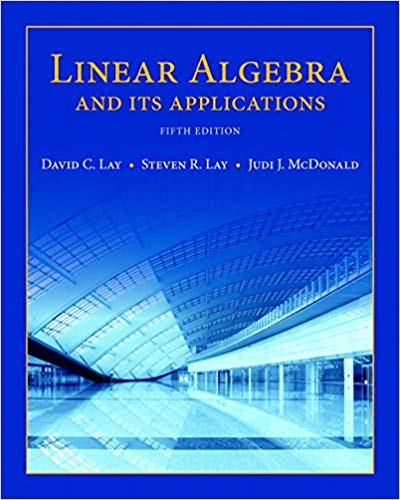
Linear Algebra and Its Applications, 5th Edition
Authors: David C. Lay, Steven R. Lay, Judi J. McDonald
ISBN-13: 978-0321982384
We have solutions for your book!
See our solution for Question 25E from Chapter 1.3 from Lay's Linear Algebra and Its Applications, 5th Edition.
Problem 25E
Chapter:
Problem:
Denote the columns of A by...
Step-by-Step Solution
Step 1
Given matrix and vector:\[\begin{array}{l}A = \left[ {\begin{array}{*{20}{c}}1&0&{ - 4}\\0&3&{ - 2}\\{ - 2}&6&3\end{array}} \right]\\\\{\bf{b}} = \left[ {\begin{array}{*{20}{c}}4\\1\\{ - 4}\end{array}} \right]\end{array}\]Also given that:\[W = {\rm{Span}}\left\{ {{{\rm{a}}_{\rm{1}}}{\rm{,}}{{\rm{a}}_{\rm{2}}},{{\rm{a}}_{\rm{3}}}} \right\}\]For the above matrix and vector we have to find the followings:
(a) Is $b$ in $\left\{ {{{\rm{a}}_{\rm{1}}}{\rm{,}}{{\rm{a}}_{\rm{2}}},{{\rm{a}}_{\rm{3}}}} \right\}$? How many vectors are in $\left\{ {{{\rm{a}}_{\rm{1}}}{\rm{,}}{{\rm{a}}_{\rm{2}}},{{\rm{a}}_{\rm{3}}}} \right\}$
(b) Is $b$ in $W$? How many vectors are in $W$?
(c) Show that $a_1$ is in $W$.
Step 2: (a)
Given Domain:\[\left\{ {{{\bf{a}}_{\bf{1}}}{\rm{,}}{{\bf{a}}_{\bf{2}}},{{\bf{a}}_{\bf{3}}}} \right\} = \left\{ {\left[ {\begin{array}{*{20}{c}}1\\0\\{ - 2}\end{array}} \right],\left[ {\begin{array}{*{20}{c}}0\\3\\6\end{array}} \right],\left[ {\begin{array}{*{20}{c}}{ - 4}\\{ - 2}\\3\end{array}} \right]} \right\}\]As we can see that the vector $b$ is not one of the vectors in the given domain, hence $b$ is not in $\left\{ {{{\rm{a}}_{\rm{1}}}{\rm{,}}{{\rm{a}}_{\rm{2}}},{{\rm{a}}_{\rm{3}}}} \right\}$. We can also notice that there are three vectors in $\left\{ {{{\rm{a}}_{\rm{1}}}{\rm{,}}{{\rm{a}}_{\rm{2}}},{{\rm{a}}_{\rm{3}}}} \right\}$, that are, \[{{\bf{a}}_{\bf{1}}}{\rm{,}}{{\bf{a}}_{\bf{2}}},\,{\rm{and}}\,\,{{\bf{a}}_{\bf{3}}}\]
Step 3: (b)
The vector $b$ will be in $W$, if $b$ is a linear combination of three vectors ${{\bf{a}}_{\bf{1}}}{\rm{,}}{{\bf{a}}_{\bf{2}}},\,{\rm{and}}\,\,{{\bf{a}}_{\bf{3}}}$. Let us write the corresponding system of Equations. \[\begin{array}{l}{x_1}{{\bf{a}}_{\bf{1}}} + {x_2}{{\bf{a}}_2} + {x_3}{{\bf{a}}_3} = {\bf{b}}\\{x_1}\left[ {\begin{array}{*{20}{c}}1\\0\\{ - 2}\end{array}} \right] + {x_2}\left[ {\begin{array}{*{20}{c}}0\\3\\6\end{array}} \right] + {x_3}\left[ {\begin{array}{*{20}{c}}{ - 4}\\{ - 2}\\3\end{array}} \right] = {\bf{b}}\end{array}\]
Step 4: The Augmented matrix
\[\begin{array}{l}M = \left[ {\begin{array}{*{20}{c}}1&0&{ - 4}&4\\0&3&{ - 2}&1\\{ - 2}&6&3&{ - 4}\end{array}} \right]\\ = \left[ {\begin{array}{*{20}{c}}1&0&{ - 4}&4\\0&3&{ - 2}&1\\0&6&{ - 5}&4\end{array}} \right]::\,{R_3} = {R_3} + 2{R_1}\\ = \left[ {\begin{array}{*{20}{c}}1&0&{ - 4}&4\\0&3&{ - 2}&1\\0&0&{ - 1}&2\end{array}} \right]::\,\,{R_3} = {R_3} - 2{R_2}\end{array}\]As we can see that the above matrix is in echelon form and has a solution. So the vector $b$ will be in $W$.
Step 5: The Row Reduced Echelon Form
\[\begin{array}{l}M = \left[ {\begin{array}{*{20}{c}}1&0&{ - 4}&4\\0&3&{ - 2}&1\\0&0&{ - 1}&2\end{array}} \right]\\ = \left[ {\begin{array}{*{20}{c}}1&0&0&4\\0&3&0&{ - 3}\\0&0&{ - 1}&2\end{array}} \right]::\,\,{R_2} = {R_2} - 2{R_3};\,\,{R_1} = {R_1} - 4{R_3}\\ = \left[ {\begin{array}{*{20}{c}}1&0&0&4\\0&1&0&{ - 1}\\0&0&{ - 1}&2\end{array}} \right]::\,\,{R_2} = {R_2}/3\end{array}\]From the above reduced echelon from, we find three scalers as $\left( {4, - 1,2} \right)$:\[4{{\bf{a}}_{\bf{1}}} - 1{{\bf{a}}_2} + 2{{\bf{a}}_3} = {\bf{b}}\]Now if we change the vector $b$, there can be another combination of these scalars. So there can be infinite vectors in W for different values of scalar combinations.
Step 6: (c)
From the above set, if we choose three scalars such that ${x_1} = 1,\,{x_2} = 0,{x_3} = 0$. Then,:\[\begin{array}{l}{x_1}{{\bf{a}}_{\bf{1}}} + {x_2}{{\bf{a}}_2} + {x_3}{{\bf{a}}_3} = {\bf{b}}\\\left( 1 \right){{\bf{a}}_{\bf{1}}} + \left( 0 \right){{\bf{a}}_2} + \left( 0 \right){{\bf{a}}_3} = {\bf{b}}\\{{\bf{a}}_{\bf{1}}} = {\bf{b}}\end{array}\]Thus ${{\bf{a}}_{\bf{1}}}$ lies in $W$.
ANSWER
(a) $b$ is not in $\left\{ {{{\rm{a}}_{\rm{1}}}{\rm{,}}{{\rm{a}}_{\rm{2}}},{{\rm{a}}_{\rm{3}}}} \right\}$. There are three such vectors.
(b) $b$ is in $W$
(c) $a_1$ is in $W$.
Given matrix and vector:\[\begin{array}{l}A = \left[ {\begin{array}{*{20}{c}}1&0&{ - 4}\\0&3&{ - 2}\\{ - 2}&6&3\end{array}} \right]\\\\{\bf{b}} = \left[ {\begin{array}{*{20}{c}}4\\1\\{ - 4}\end{array}} \right]\end{array}\]Also given that:\[W = {\rm{Span}}\left\{ {{{\rm{a}}_{\rm{1}}}{\rm{,}}{{\rm{a}}_{\rm{2}}},{{\rm{a}}_{\rm{3}}}} \right\}\]For the above matrix and vector we have to find the followings:
(a) Is $b$ in $\left\{ {{{\rm{a}}_{\rm{1}}}{\rm{,}}{{\rm{a}}_{\rm{2}}},{{\rm{a}}_{\rm{3}}}} \right\}$? How many vectors are in $\left\{ {{{\rm{a}}_{\rm{1}}}{\rm{,}}{{\rm{a}}_{\rm{2}}},{{\rm{a}}_{\rm{3}}}} \right\}$
(b) Is $b$ in $W$? How many vectors are in $W$?
(c) Show that $a_1$ is in $W$.
Step 2: (a)
Given Domain:\[\left\{ {{{\bf{a}}_{\bf{1}}}{\rm{,}}{{\bf{a}}_{\bf{2}}},{{\bf{a}}_{\bf{3}}}} \right\} = \left\{ {\left[ {\begin{array}{*{20}{c}}1\\0\\{ - 2}\end{array}} \right],\left[ {\begin{array}{*{20}{c}}0\\3\\6\end{array}} \right],\left[ {\begin{array}{*{20}{c}}{ - 4}\\{ - 2}\\3\end{array}} \right]} \right\}\]As we can see that the vector $b$ is not one of the vectors in the given domain, hence $b$ is not in $\left\{ {{{\rm{a}}_{\rm{1}}}{\rm{,}}{{\rm{a}}_{\rm{2}}},{{\rm{a}}_{\rm{3}}}} \right\}$. We can also notice that there are three vectors in $\left\{ {{{\rm{a}}_{\rm{1}}}{\rm{,}}{{\rm{a}}_{\rm{2}}},{{\rm{a}}_{\rm{3}}}} \right\}$, that are, \[{{\bf{a}}_{\bf{1}}}{\rm{,}}{{\bf{a}}_{\bf{2}}},\,{\rm{and}}\,\,{{\bf{a}}_{\bf{3}}}\]
Step 3: (b)
The vector $b$ will be in $W$, if $b$ is a linear combination of three vectors ${{\bf{a}}_{\bf{1}}}{\rm{,}}{{\bf{a}}_{\bf{2}}},\,{\rm{and}}\,\,{{\bf{a}}_{\bf{3}}}$. Let us write the corresponding system of Equations. \[\begin{array}{l}{x_1}{{\bf{a}}_{\bf{1}}} + {x_2}{{\bf{a}}_2} + {x_3}{{\bf{a}}_3} = {\bf{b}}\\{x_1}\left[ {\begin{array}{*{20}{c}}1\\0\\{ - 2}\end{array}} \right] + {x_2}\left[ {\begin{array}{*{20}{c}}0\\3\\6\end{array}} \right] + {x_3}\left[ {\begin{array}{*{20}{c}}{ - 4}\\{ - 2}\\3\end{array}} \right] = {\bf{b}}\end{array}\]
Step 4: The Augmented matrix
\[\begin{array}{l}M = \left[ {\begin{array}{*{20}{c}}1&0&{ - 4}&4\\0&3&{ - 2}&1\\{ - 2}&6&3&{ - 4}\end{array}} \right]\\ = \left[ {\begin{array}{*{20}{c}}1&0&{ - 4}&4\\0&3&{ - 2}&1\\0&6&{ - 5}&4\end{array}} \right]::\,{R_3} = {R_3} + 2{R_1}\\ = \left[ {\begin{array}{*{20}{c}}1&0&{ - 4}&4\\0&3&{ - 2}&1\\0&0&{ - 1}&2\end{array}} \right]::\,\,{R_3} = {R_3} - 2{R_2}\end{array}\]As we can see that the above matrix is in echelon form and has a solution. So the vector $b$ will be in $W$.
Step 5: The Row Reduced Echelon Form
\[\begin{array}{l}M = \left[ {\begin{array}{*{20}{c}}1&0&{ - 4}&4\\0&3&{ - 2}&1\\0&0&{ - 1}&2\end{array}} \right]\\ = \left[ {\begin{array}{*{20}{c}}1&0&0&4\\0&3&0&{ - 3}\\0&0&{ - 1}&2\end{array}} \right]::\,\,{R_2} = {R_2} - 2{R_3};\,\,{R_1} = {R_1} - 4{R_3}\\ = \left[ {\begin{array}{*{20}{c}}1&0&0&4\\0&1&0&{ - 1}\\0&0&{ - 1}&2\end{array}} \right]::\,\,{R_2} = {R_2}/3\end{array}\]From the above reduced echelon from, we find three scalers as $\left( {4, - 1,2} \right)$:\[4{{\bf{a}}_{\bf{1}}} - 1{{\bf{a}}_2} + 2{{\bf{a}}_3} = {\bf{b}}\]Now if we change the vector $b$, there can be another combination of these scalars. So there can be infinite vectors in W for different values of scalar combinations.
Step 6: (c)
From the above set, if we choose three scalars such that ${x_1} = 1,\,{x_2} = 0,{x_3} = 0$. Then,:\[\begin{array}{l}{x_1}{{\bf{a}}_{\bf{1}}} + {x_2}{{\bf{a}}_2} + {x_3}{{\bf{a}}_3} = {\bf{b}}\\\left( 1 \right){{\bf{a}}_{\bf{1}}} + \left( 0 \right){{\bf{a}}_2} + \left( 0 \right){{\bf{a}}_3} = {\bf{b}}\\{{\bf{a}}_{\bf{1}}} = {\bf{b}}\end{array}\]Thus ${{\bf{a}}_{\bf{1}}}$ lies in $W$.
ANSWER
(a) $b$ is not in $\left\{ {{{\rm{a}}_{\rm{1}}}{\rm{,}}{{\rm{a}}_{\rm{2}}},{{\rm{a}}_{\rm{3}}}} \right\}$. There are three such vectors.
(b) $b$ is in $W$
(c) $a_1$ is in $W$.